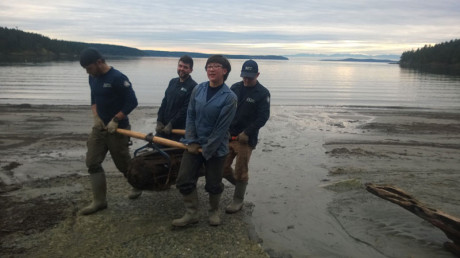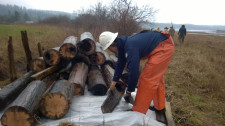Removing the Creosote
Posted March 31, 2015 at 5:45 am by Tim Dustrude
Toxic creosote treated wood removed from local beaches
Over the past month, restoration crews from the WA Department of Natural Resources (DNR) have removed over 50 tons of toxic creosote treated wood from public and private beaches on Lopez, Orcas and San Juan Islands. Special thanks to the Puget Sound Conservation Corps members who did the hard work and to the concerned individuals who reported creosote debris to FRIENDS of the San Juans for their support of improved beach conditions for people, fish and wildlife.
Creosote-treated wood was commonly used in marine structures throughout the Salish Sea for more than a century during a period of rapid development and industrial expansion. Like other chemical compounds that were innovations in their time, creosote was broadly used without knowledge of its long-term consequences. It is now known that creosote contains more than 50 carcinogens to humans and is toxic to marine fish and other wildlife. Much creosote remains in local waters today, washing in with storms and tides and persisting in older structures such as docks and pilings.
“FRIENDS of the San Juans is continuing its partnership with the DNR to remove unnecessary toxic creosote-treated pilings and outdated structures from tidelands in San Juan County at no cost to interested landowners this summer. The goal of the project is to improve water quality and overall ecosystem health for salmon and salmon prey,” said Tina Whitman, FRIENDS’ Science Director.
FRIENDS and DNR are currently seeking property owners who have in-water creosote-treated wood such as unused pilings or derelict docks that they are interested in removing. To find out if your structure is eligible for this voluntary and free removal program, please contact Tina Whitman (FRIENDS) at 360-378-2319 or Chris Robertson (DNR) at 360-854-2808.
FRIENDS and DNR are also interested in receiving information about beach sites with large accumulations of drift creosote materials; this material may eligible for removal through the same DNR Puget Sound Corps Program that just completed removals over the past few weeks.
FRIENDS received funding from the Washington State Salmon Recovery Funding Board to coordinate the local effort in San Juan County. This is part of the state-wide DNR Creosote Removal Program in which more than 19,823 tons of creosote 276,000 square feet of overwater structures and 3,972 tons of toxic beach debris have been removed from the Salish Sea to date.
You can support the San Juan Update by doing business with our loyal advertisers, and by making a one-time contribution or a recurring donation.
Categories: Around Here
One comment:












One comment...
Thank you to Friends of the San Juans and DNR for the all important work of creosote removal. I understand that creosote is one of the main contributors of PCBs in the marine environment that is compromising the survivability of our resident Orcas.
By submitting a comment you grant the San Juan Update a perpetual license to reproduce your words and name/web site in attribution. Inappropriate, irrelevant and contentious comments may not be published at an admin's discretion. Your email is used for verification purposes only, it will never be shared.